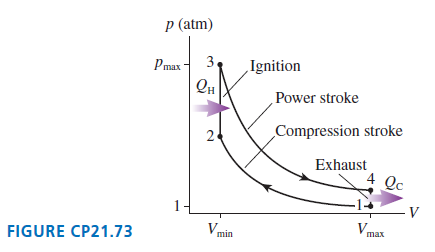The gasoline engine in your car can be modeled as the Otto cycle shown in FIGURE CP21.73.
Question:

a. Analyze the Otto cycle and show that the work done per cycle is

b. Use the adiabatic connection between T1 and T2 and also between T3 and T4 to show that the thermal efficiency of the Otto cycle is

where r = Vmax /Vmin is the engine€™s compression ratio. c. Graph h versus r out to r = 30 for a diatomic gas.
Fantastic news! We've Found the answer you've been seeking!
Step by Step Answer:
Related Book For 

Physics for Scientists and Engineers A Strategic Approach with Modern Physics
ISBN: 978-0133942651
4th edition
Authors: Randall D. Knight
Question Posted:





